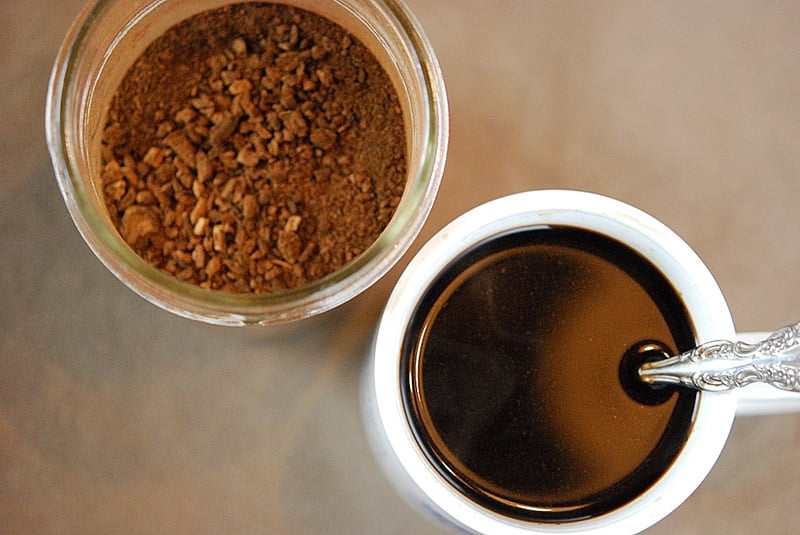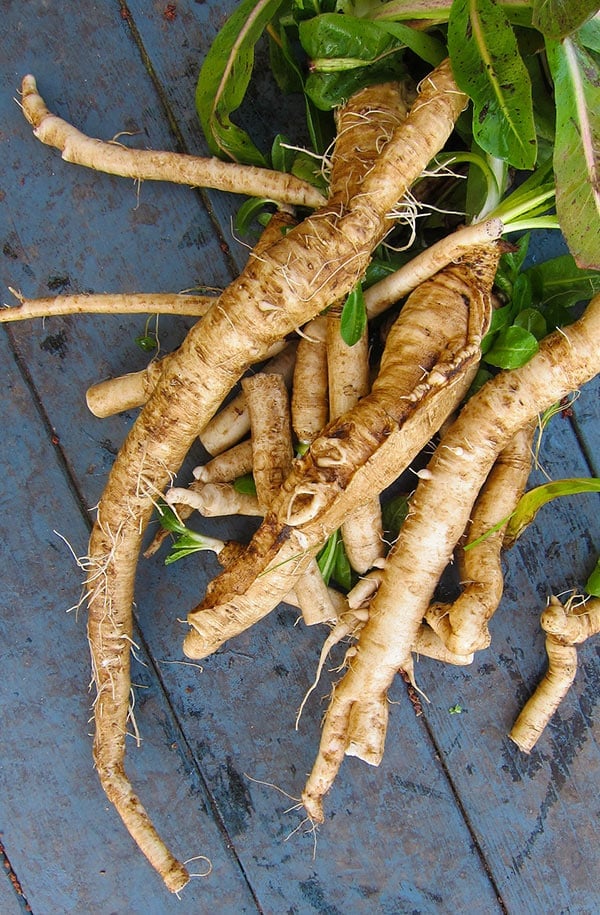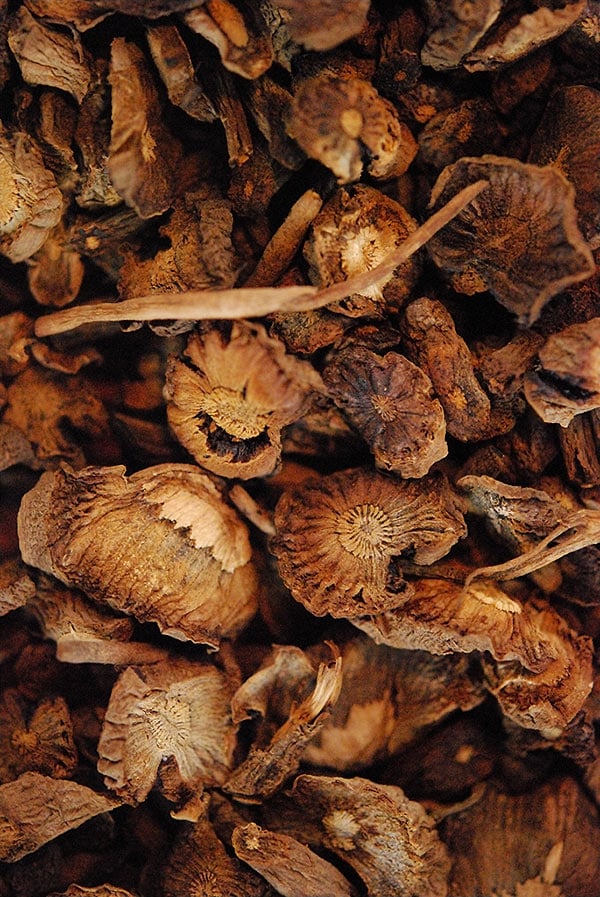As an Amazon Associate I earn from qualifying purchases.

For a time, my favorite coffee was New Orleans style, where the coffee is cut with roasted, ground chicory root. Chicory coffee is smooth, a little more acidic than normal coffee, with a taste and aroma similar to a mocha — and it makes a drink darker than the inside of a cow.
I used to Ozark it up even more by drinking it black, sweetened with molasses, not sugar. Definitely a manly drink, and probably the reason I have so much hair on my chest. I imagined lumberjacks or pioneers drinking this between cutting wood or fording wild rivers.
I was not in the habit of doing either, so I ultimately switched back to straight coffee. Actually I stopped because the canned chicory coffee I’d been buying grew pretty grim on my tastebuds over time; stale and dusty tasting. I never found anyone who made a premium version, so I left chicory coffee by the wayside.
I knew I could make my own by digging up the raggedy sailors — chicory is that weedy azure-blue flower that grows on a roadside near you. But I’d never bothered with it, as you need to dig in fall, and I only really notice this plant in summer when it’s flowering, or in early spring when I eat the greens.
But then I bought some “root chicory” seeds and planted them. Now I had absolutely no intention of making chicory coffee from them. I have a thing for crazy root vegetables, and it is my contention that if more locovores living in Northern climates grew a wider variety of roots, their winter menus would be far more interesting. I wanted to test this root out as a vegetable, so I planted it in my root bed next to the scorzonera I experimented with this year.
And then, as typically happens, life got in the way. I looked up and it was May already — while the chicory roots had not yet sent up flower stalks (except for one), they would be far too bitter and “hot” to eat as a veggie. Damn.
What to do with these things? I pulled one and was astounded at how large it was: A good 30 inches, with a base about two inches across. Christ, that’s a big root. And then I remembered my lumberjack coffee. But just how do you make chicory coffee?
I’d read a few sets of instructions that say just wash and dry the roots, then roast them in a moderate oven until “ready,” then break into pieces and grind into coffee-like grounds. I knew intuitively that this was false. I could not imagine breaking a root that was two inches broad into pieces small enough to not kill my grinder.

Other sets of instructions, mostly for making dandelion coffee (basically the same thing), call for slicing the roots into thin discs, then drying them, then roasting them, and then grinding them. This sounded more sane.
So I began slicing up the 20-or so large chicory roots I’d managed to pull. I ate a few raw, and they weren’t terrible: If something can manage to be sweet and bitter at the same time, these roots achieved that feat.
When I was doing this, it was 104°F outside. Not ideal oven drying weather, but perfect weather to dry things outside. And my “drying rack” of choice is the hood of my pickup. So I sat these sliced roots out in the sun, and they dried nicely in two days.
When it came time to roast the chicory, I found even more misleading instructions on the internet; yes, I know — misleading information on the internet?! Heavens! Everyone seems to say roast dandelion or chicory root in a 350°F oven for 10 to 15 minutes. Uh, yeah. You then have slightly warmer dried chicory roots. Nope, instead of 15 minutes, try 90 minutes, or even two hours. I might try 2 to 3 hours at a lower temperature next time.

I’d just like to say that even if you have no intention of actually drinking chicory coffee, it is worth roasting the roots this way. The whole house smelled wonderfully malty, chocolatey, warm. So lovely.
I let the roots cool overnight and ground them. Unfortunately they don’t seem to grind evenly, so I have powder mixed with chunks. But I use a press pot for my coffee, whose filter is enough to strain it all out.
I decided to brew myself a straight cup of chicory coffee. I put about a 1/4 cup into my press pot, the same amount I use for coffee, boiled some water and steeped the inky brew for about 5 to 8 minutes. I drank it black, with sugar.
Straight chicory coffee is some powerful stuff. it tastes like it is loaded with caffeine, but it isn’t. It looks a lot like motor oil, has that malty-chocolate aroma, a brighter acidity than coffee and a flavor I really am having trouble describing as other than with the cliche “earthy.” Guess that’s what I get for roasting a root.




Believe it or not, I live where chicory does not grow wild, so I planted it in my kitchen garden. I might have to re-think that, though, now that I know about your 20 inch long roots…..I’m going to need a bigger pot. 🙂
Can’t wait to roast the root and try chicory coffee-thank you for sharing your knowledge and experience!
Chicory roots are best harvested after they are frosted in the first season. I love the taste, and it has many health benefits; particularly for the liver. One can never go wrong growing and partaking of one’s own foods and beverages. Besides the obvious savings at the grocery store, every good herb eaten adds to one’s health savings bank. The wild chicory that grows everywhere makes large roots and are fine for harvesting. Gather seed in the summer and scatter where you want it to come up in the spring. Chicory is a very close cousin to the dandelion, and also to radicchio. Enjoy the health benefits of the whole family in salads and as dried roots.
I read your post the first time I roasted chicory, back a couple years ago.
I had only had Cafe Du Monde from New Orleans coffee, but I started roasting my own green coffee beans years ago, and this seemed like a suitable step.
Never one to forage our county’s sprayed-roadsides, we never had chicory in our yard until we had a really hot, dry summer following a warm, wet spring. Suddenly, chicory was everywhere, I was elated!
it’s been moderately warm here, and a little dry, so for about a month I’ve been watching a few plants that reappeared in our front yard. Like the young trees I planted this spring, I gave the chicory nursery a protective straw surround so my husband wouldn’t mow them down.
Today, they’re over a foot tall, so I decided to pull some. I pour some warm water over the root. My roots look NOTHING as big as yours–mine are more the size of dandelion roots here. But, I did get one a foot long, and a few plants. Good enough for a few pots of coffee, or 10-15 cups of single-brew.
Anyway, my chicory is roasting in the oven now. I’d love to know where you bought your chicory root seeds! I don’t see any seeds, but am guessing I’d find them in the flower, but I really don’t see any when I looked. Guessing I have to plant from actual seed like you did.
Many thanks for your post. I like your writing style and your description. Your “chicory-discs” make me jealous–they remind me of sliced succulent ginger root!
Oh, to have chicory like your photos.
If you don’t mind sharing where you bought your seeds, that is great.
Now I’m off click your link on scorzonera. Never heard of it.
Good Morning Hank, I read and enjoyed your post very much. I am currently working on building an organic garden and however my space is limited, I am looking for Chicory root seeds with good quality. Where do you recommend I go to find the good seeds? Thank you for reading this, have a great chicory morning! Elle
I have chicory growing wild everywhere in my yard. Wanted to have some yard back before fall. If I cut chicory now (early August) can I still dig up roots in fall?
seems like you get your dinner as well as your cup of coffee with this plant. seems to grow alright in Tasmania, but loves the cold. Going to see how i go when it comes to the taste test.
I want to see if I can get some seeds and grow it at my place in Mexico. What was the type of seed you bought? What did it look like?
Thanks
G
Katie: I’ve done this every year since I first wrote this piece in 2009. I absolutely would (and do) do it again. In fact, I just harvested my 2012-2013 crop!
I have a follow up question…before I go and get seeds. Would you do it again? Was it worth it? I would grow it for coffee because I too miss NOLA’s coffee. I would most likely mix it with my favorite coffee & not go straight. Mixed with coffee, does it bring you back to New Orleans?
We make dandelion coffee by a similar process. The roots are washed and dried a bit, chopped finely then roasted for hours in a moderate oven ( we also leave them all night when the wood-burning stove is idling through the night) then grind . We also get the uneven grind you describe, but this is fine in a cafetiere or french press.
fantastic description of this interesting subject. I read in a write up dated 1874, that the chicory was treated with oil or fat prior (?) to roasting. Just wondering if anyone had information on this.
Hi, Can anyone tell me if chicory is grown in New Zealand
I’d buy roots off a farmer – if not where can I get seeds
to plant in my garden – is chicory root different to endive?
Endive is a vegetable I can get those seeds but they are not
a wildflower with a blue flower.
Thanks.
Hi Hank,
I first experienced chicory coffee in South Africa (studying there) I haven’t been able to find it pre-blended here in Indiana. When I found some chicory root at the local farmers co-op I picked some up. I found your site looking for instructions on what to do with the stuff. Thank you for actually having practical instructions that make sense!
So now I get to enjoy great, fresh chicory coffee, and I’ve found a great new website for recipes! Double bonus!
Hi Hank, Thank you so much for describing the process.
I got chicory by the roadside in New England and just scattered the old flowers into my sunny garden. The plants came up, but i waited a few years before harvesting in case there were road toxins in them… I’ve made coffee from Wild Carrot root, Queen Anne’s Lace root… Love it. Karin
I’m currently growing chicory purchased from “Seeds Of Italy”. They grew exceptionally large and fat. On searching to find info on how to process them, found your blog. Very interesting info.
I grew up on Lusianne’s Coffee and Chicory, and honestly was an adult before I learned that coffee could be a drink by itself. I drank Postum for many years afterward until it was no longer available on store shelves.
In order to cut the bitter edge, I plan on roasting wheat berries and combining them with the chicory roots. If I remember correctly, Postum was a combination of roasted wheat and bran added to the chicory root. It made for a mild, better tasting brew.
what olivia said. i’m going to try this this week i think. 🙂
I’ve been meaning to try it since coffee is so darn expensive and we have some chicory in our garden, so it’s time to take the next step. Thanks.
Thank you for the info. Beautifully written!
Because I am sensitive to caffeine I was using Teecino ( a blend of roasted barley, chicory, carob,dates, almond, ect….) and I really enjoyed all the different flavors it comes in. Then I found out I am gluten sensitive and the barley was causing problems. I tried to find roasted chicory and carob online (to make my own barley free mix) and found that Frontier Natural Products Co-Op carries both and so much more. The quality is rich and aromatic. I fill a pint size container with a mix of the chicory and carob and freeze the rest. It’s been 6 months since I bought the original bags and they still taste as fresh as when they first arrived on my porch.
Thanks so much Hank for the info. I’ve been admiring these beautiful flowers for years not knowing what they were until my mom told me last summer while picking blackberries in the cow pasture. I’ve been curious about harvesting them, but wasn’t sure when the proper time was to harvest the root. I had no idea you could eat the root, leaves and use the whole stinkin’ plant! I do remember Postum and loved it! Can I just harvest the wild roots? I thought about maybe trying to collect some of the seeds, but when do they go to seed? And how to recognize them amongst the weeds? If nothing else, I might just order some seeds, if I can.